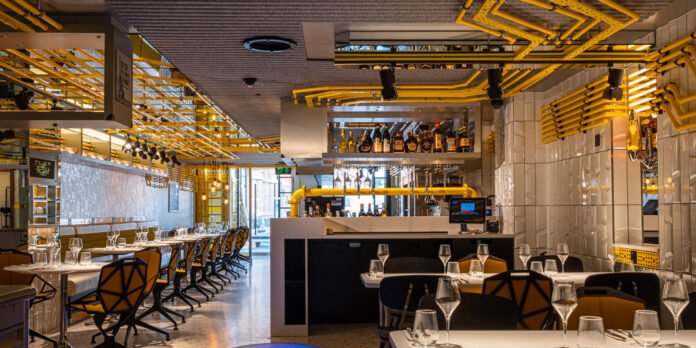If you love pasta and you’re planning to eat out in the city, you’ll want to find a good pasta restaurant London that serves more than just spaghetti and tomato sauce. Good pasta is about fresh ingredients, perfect timing, and bold flavors. A great meal doesn’t need fancy ingredients—just real ones that taste great together. In a city like London, where food choices are everywhere, it helps to know which restaurants actually care about the food on your plate.
Fresh Pasta Matters
You can taste the difference between fresh and dried pasta. Fresh pasta is soft, often made with eggs, and usually cooked for just a couple of minutes. It pairs well with light sauces like butter, sage, or creamy cheese blends. Most good restaurants prepare it daily, either in-house or from a local supplier.
If a place has an open kitchen or pasta-making counter, that’s a good sign. It means they take the time to prepare things from scratch. Dishes like tagliatelle, pappardelle, or ravioli are best when made fresh. Ask your server if the pasta is made on-site. If they say yes, that’s a win.
Look for Real Italian Dishes
A good Italian restaurant won’t just serve carbonara and lasagna. It will offer dishes that reflect different parts of Italy. Northern Italian pasta tends to be rich, with butter, cheese, or meat sauces. In the south, you’ll find tomato, olive oil, and seafood as common ingredients.
Try looking for dishes like:
- Orecchiette with sausage and broccoli rabe
- Pici with duck ragu
- Trofie with pesto from Liguria
- Spaghetti alle vongole (clams with garlic and white wine)
These show the restaurant knows Italian food beyond the basics.
Simple Menus Are Often Better
Some restaurants have long menus, but more options don’t always mean better food. A good pasta place often keeps it short. This allows the kitchen to focus on doing a few dishes really well. Look for menus with about 5 to 7 pasta options. This usually means fresh ingredients and better attention to detail.
You’ll often notice a seasonal menu too. That’s another good sign. It means the chef uses ingredients that are fresh and local. In spring, that might mean asparagus or peas. In autumn, you’ll likely see mushrooms or pumpkin.
Pay Attention to the Sauce
Pasta and sauce should work together. Some sauces are meant to stick to certain shapes. For example:
- Thick sauces like ragù go well with flat pasta like pappardelle.
- Light sauces are better with thin noodles like spaghetti.
- Chunky sauces work best with short pasta like rigatoni.
If a restaurant serves penne with a thin, watery sauce, it might not be the best choice. A good chef will match the pasta and sauce with care.
Don’t Ignore the Small Details
The best pasta restaurants pay attention to small things:
- Is the pasta salted well?
- Does the sauce coat the noodles properly?
- Are toppings used to add flavor, not just for looks?
Parmesan should be offered fresh—not the powdered kind. Basil should smell fresh, not dried. Even the bread on the table can tell you a lot about how much a place cares.
Good Pasta Isn’t Always Expensive
Some of the best meals come from small kitchens with no fuss. You don’t always need to go to a fine dining place to get amazing pasta. London has many smaller restaurants where the food tastes homemade. These spots often have better value for money.
Check online reviews, but also trust your instincts. A busy restaurant on a weekday is usually a good sign. So is seeing Italian guests eating there.
Friendly Staff Make a Big Difference
How you’re treated can shape your whole meal. The best pasta places make you feel welcome. Staff should be able to explain dishes if you have questions. If you’re not sure what to pick, they might suggest something based on your taste.
Also, look at how well the staff understand the food. Can they tell you what’s in the sauce? Do they know how the pasta is made? That kind of knowledge shows they care about what they serve.
Great Drinks Make the Meal Better
Wine and pasta go hand in hand. A good restaurant will have wines that go with their food—not just the most expensive bottles. Italian reds like Chianti or Barbera go well with rich meat sauces. Whites like Vermentino or Pinot Grigio are nice with seafood or lighter pasta.
If you don’t drink wine, ask for recommendations on Italian sodas or sparkling water. Some places even offer special spritzes or cocktails that go well with pasta dishes.
What About Vegetarians or Gluten-Free Diners?
Many pasta restaurants now offer vegetarian and gluten-free options. Look for menus that clearly mark these dishes. If you’re avoiding gluten, check if the pasta is made with rice or corn flour. Some restaurants also serve zucchini noodles or gluten-free gnocchi.
Vegetarian options should be more than just pasta with tomato sauce. Good restaurants might offer mushroom, truffle, or cheese-based sauces that are full of flavor.
Dessert Is the Final Test
Don’t skip dessert. A real Italian spot will offer things like tiramisu, panna cotta, or cannoli. These are classic and simple but hard to do well. If the pasta was great and the dessert matches, you’ve probably found a place worth returning to.
Italian Meals That Feel Like Home
Whether you’re going out with friends, having a date night, or just craving something comforting, a good pasta restaurant London is worth the search. The best ones serve dishes that are made with care, offer real Italian taste, and give you a warm, welcoming experience.
If you’re looking for a place to try, Spagnoletti near King’s Cross is a good choice. They serve pasta made fresh, offer a wide range of Italian classics, and create a cozy place where you can enjoy a meal that feels both simple and special.



